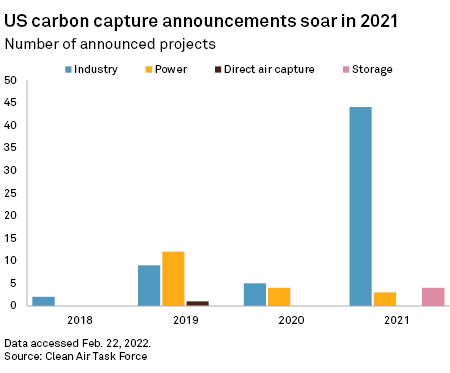S&P Global Offerings
Featured Topics
Featured Products
Events
S&P Global Offerings
Featured Topics
Featured Products
Events
S&P Global Offerings
Featured Topics
Featured Products
Events
Banking & Capital Markets
Economy & Finance
Energy Transition & Sustainability
Technology & Innovation
Podcasts & Newsletters
Banking & Capital Markets
Economy & Finance
Energy Transition & Sustainability
Technology & Innovation
Podcasts & Newsletters
S&P Global Offerings
Featured Topics
Featured Products
Events
23 Feb, 2022
By Karin Rives
The 2018 expansion of federal tax credits for carbon capture projects resulted in a record 51 new U.S. projects announced in 2021, but proponents of the nascent technology say federal policies need a major boost to take carbon management to scale.
Climate experts believe the world must use carbon capture as one tool to rein in greenhouse gas emissions and keep Earth's temperatures from rising past the critical 1.5 degrees Celsius from preindustrial days. But so far, implementing the technology has proven elusive because of the high cost of sequestering a single ton of carbon, especially from certain facilities.

To effectively capture and bury carbon dioxide from high-emitting cement, steel and hydrogen manufacturing facilities — and eventually from power plants — lawmakers must pass the Biden administration's proposed Build Back Better legislation, Lee Beck of the Clean Air Task Force told a Feb. 22 media briefing.
The approximately $2 trillion bill, unable to pass the evenly divided Senate, would extend the window for projects to qualify for projects to 2031. It would also boost the 45Q tax credit from $50 to $85 per ton for facilities that capture and store carbon and to $180 per ton for carbon captured from the atmosphere. So far, most carbon capture projects have proven uneconomical.
By 2035, an $85 tax credit could keep 100 million tons of carbon from industrial plants out of the atmosphere, Beck said, citing research from the Rhodium Group. In the U.S., such plants account for 23% of total emissions, and an even larger share if their electricity use is included. "It has a transformative impact … really making the investment in decarbonization through carbon capture in cement, steel and hydrogen economic for the first time," said Beck, international carbon capture director for the CATF.
If enacted, the Build Back Better bill would build on the $1.2 trillion bipartisan infrastructure law that U.S. President Joe Biden signed in November 2021. The infrastructure bill appropriated up to $5 billion for carbon capture demonstration and pilot projects over the next five years.
Twelve carbon capture and storage projects are operating in the U.S. today, primarily in the natural gas processing and ethanol production industries, according to the Global CCS Institute. Owners of several natural gas and coal-fired power plants have announced new projects in recent years, but none are operating yet.
The seven carbon capture projects that have received or announced financing since 2018 are all either geologic storage facilities or enhanced oil recovery projects, according to the Clean Air Task Force, which tracks the industry. More than 20 of the 84 projects announced as of 2021 are going through early engineering studies.
"We need to get these over the finish line to move toward a clean and competitive industrial sector," said Zoe Lipman, deputy director for the AFL-CIO's Industrial Union Council. "Done right, these policies will provide the domestic and global markets we need to ramp up production of clean materials."
Carbon capture has broad bipartisan support. Democrats generally believe the technology is needed to tackle climate change, while some Republican states hope it can prolong the life of coal- and natural gas-fired power plants that bring jobs and revenue.
